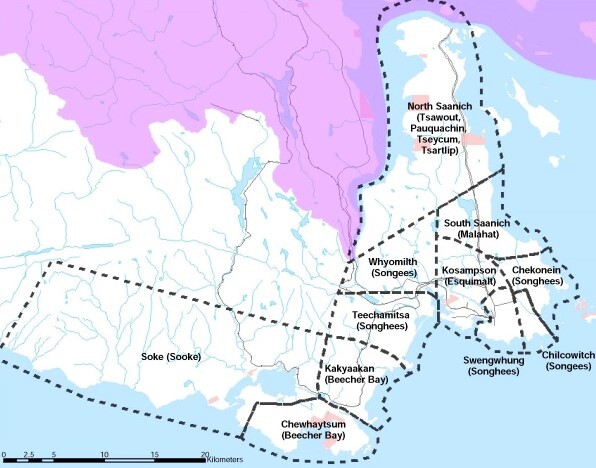By Nicole Stanbridge, Curator of Engagement
The ocean that surrounds this region of southern Vancouver Island [i], the rivers, the lakes, the water we drink, and the land we live on, are all the traditional territories of the Coast Salish peoples. Victoria is located on the traditional unceded territory of the Lekwungen speaking peoples, the Esquimalt and Songhees First Nations. In 1850, James Douglas, an agent of the Crown, was appointed authority by the colonial office in London to establish a colony on Vancouver Island. The fourteen purchase agreements (Douglas Treaties or Vancouver Island Treaties) that Douglas completed with Vancouver Island Indigenous nations are transcribed on the Government of Canada website. (https://www.rcaanccirnac.gc.ca/eng/1100100029052/1581515763202)
part of a larger project with local nations and University of Victoria researchers (https://hcmc.uvic.ca/songheesconference/ ) to look into oral history and archives to better understand what took place at the time of the signing of these documents. As told by the late WSÁNEĆ elder Dave (PENÁĆ) Elliott Sr. in his book Saltwater People, (http://www.islandstrust.bc.ca/media/341928/saltwater-people-1983-delliot-sr.pdf) their ancestors present at the signing of these agreements understood these as Peace Treaties, not purchase agreements. There were significant language barriers between the colonists and First Nations at that time that would have made it challenging for them to comprehend the precise intention of what is written in these documents. Therefore, to what extent the agreements would impact their rights to land and resources was not clearly communicated. Many of the names of the First Nations members on these documents are inaccurate or unknown to the families of the Teechamitsa, Kosampsom, Swengwhung, Chilcowitch, Whyomilth, Che-ko-nein, Ka-ky-aakan, Chewhaytsum, Sooke and Sooke Inlet, North and South Saanich, Queackar, Quakeolth, and
Saalequun peoples who are named in the Douglas Treaties. In addition to this questionable treaty process, the colonists did not live up to what was promised to the First Nations in those agreements, that is “to keep enclosed
and village sites” to “hunt and fish as formerly”.

Mi’kmaq have a right to harvest fish for food, social and ceremonial purposes and a right to fish for a moderate livelihood.”[ii] Those opposing the fishery were challenging what constitutes “to fish for a moderate livelihood”, and claiming conservation concerns which were unfounded. What this highlights is the racism inherent in the desire for control over resources and subsequent profit, in lieu of working with Indigenous communities to ensure livelihood, wellbeing and continuation of cultural practices. Closer to home we see the disregard for treaty rights and cultural practices with pipeline expansion, and “infrastructure projects” like Site C Dam. The colonial project in this country has had a devastating impact on Indigenous cultural practices and ways of being. This connection to land, water and natural resources within Indigenous communities are the basis for cultural practices, language, governance, economies, food, shelter, and wellbeing.
Many movements and actions by Indigenous land defenders are taking place at any given time from the international movement of Idle No More (https://idlenomore.ca/) to Tiny House Warriors in Secwepemc Territory (http://www.tinyhousewarriors.com). Indigenous communities across the country are endlessly working to protect their land from destructive resource extraction, economic exploitation, and irreversible ecological harm. This should be of concern for all of us, the colonial framework that we live in is no longer sustainable. We need to be responsible to the land that supports us and to those who have been its stewards since time immemorial. The more we know about these treaties, the better equipped we are to take action, redress the damages caused by the colonial history of this country, and to support Indigenous communities. We all need to be invested in this urgent work; across cultures, sectors, and disciplines.
Further resources and links:
[i] The colonial name attributed to Vancouver Island came from Captain George Vancouver (22 June 1757 – 10 May 1798) a British officer of the Royal Navy known for his 1791–95 expedition, which covered North America’s northwestern Pacific Coast regions, including the coasts of what are now known as the American states of Alaska, Washington, and Oregon, as well as the Canadian province of British Columbia.
[ii] https://theconversation.com/nova-scotia-lobster-dispute-mikmaw-fishery-isnt-a-threat-to-conservation-say-scientists-148396
Feature image: Map of First Nations named in Douglas Treaty



